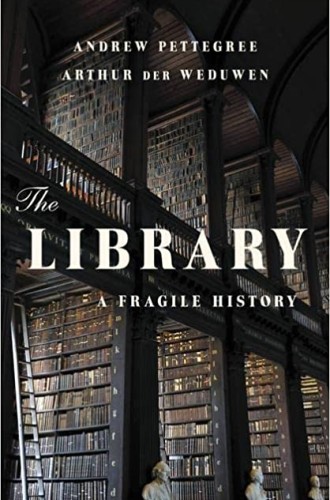Is it possible to tell the complete history of libraries?
Andrew Pettegree and Arthur der Weduwen try in their impressive but Eurocentric volume.
Writing a complete history of libraries is no easy task. One must address questions of definition, purpose, accessibility, and function. Not only are there no single answers to these questions, but the answers change over time and vary from region to region. Andrew Pettegree and Authur der Weduwen take on this difficult assignment in their impressively researched work. Unfortunately, they only partially succeed. They leave many of these essential questions unanswered in what is ultimately a limited, Eurocentric history of libraries.
The history of libraries cannot be separate from the evolution of the book. The authors, therefore, recount the development of texts from clay tablets to papyrus and parchment scrolls to codices or manuscript books, and then to the first printed books, known as incunabula, produced through the revolutionary movable-type printing press. They then describe later developments such as the cheap novels of the 19th century, the introduction of paperbacks in the early 20th, the first digital books produced on CD-ROM, and later e-book readers. Alongside this history we also learn about other media advancements that both competed with and complemented books: newspapers, magazines, radio, movies, television, and the internet.
Read our latest issue or browse back issues.
As books and media evolved, so did libraries. The authors discuss imperial libraries and national libraries, monastic libraries and parish libraries, the museum-like collections of antiquarians and the personal working libraries of professionals, clergy, and scholars. They write about town libraries, subscription and circulating libraries, and public libraries.
We are also introduced to many of the eccentric and innovative characters who helped create these libraries. Fernando Colón (1488–1539), son of Christopher Columbus, sought to create a universal library reminiscent of the ancient Library of Alexandria. Henry Folger (1857–1930), an oil executive who was singularly focused on the study of William Shakespeare, was willing to spend tens of thousands of dollars on single volumes. Andrew Carnegie (1835–1919), a ruthless businessman turned philanthropist, did not collect books but built over 2,500 public libraries. In the stories of libraries and collectors throughout history, Pettegree and Der Weduwen reveal that books were collected not only for practical use, but also as symbols of status and expressions of values.
Despite the many fascinating details included in this history, much is omitted. Most troubling is the lack of information about libraries of the world outside Europe and the United States. While the authors acknowledge the oldest known library in ancient Assyria and briefly mention the impressive manuscript collections in Africa, the Middle East, and East Asia, they ultimately ignore these collections because these regions “did not follow Europe in embracing the mass production of print.” This logic, though, does not prevent Pettegree and der Weduwen from spending three chapters on European manuscripts. The other areas of the world only come back into the authors’ history when European colonialists bring their books, “a totem of civilisation,” to these regions.
Much is neglected too in the history of European libraries. The authors dismiss the importance of e-books because of the obsolescence of early technology like the CD-ROM and the decline in the use of e-readers. Here they seem oblivious to the fact the technology has evolved so that people now read e-books on their phones and tablets. Likewise, the authors overlook the long and fascinating history of audiobooks.
Pettegree and der Weduwen also spend little time on academic libraries, save for a few pages on Oxford’s Bodleian Library and Harvard’s library. Neither do we learn much about the inner workings of libraries, except for an occasional detail like the revolutionary use of horizontal shelves or the method of organizing books by scholarly faculties, such as theology, medicine, and science. While Pettegree and der Weduwen name the Dewey Decimal Classification system, there is no mention that it is now the most widely used system in the world, no discussion on the theory behind the system, and no explanation of the problematic bigotry embedded within it.
The authors, moreover, fail to provide a sense of what librarians have done beyond collecting books, even after the role evolved into a profession. And they say very little about library patrons. Who used these libraries? What were the criteria for doing so? Who was not only allowed but able to use them? Outside of their discussion of public libraries, the authors overlook these questions.
Even with these omissions, Pettegree and der Weduwen reveal an essential aspect of the history of libraries that still has much relevance today. As they indicate in the subtitle and show through the book, this history is not a story of growth and progress. It has been shaped by struggle. Libraries have regularly faced destruction due to neglect, conflict, and natural disaster.
The biggest threat, perhaps, has come from the self-appointed gatekeepers of knowledge and taste—political leaders, religious leaders, and even librarians—who seek to control what others may read. Most do not go to the extreme of the Roman emperor Domitian, who reportedly executed the author, seller, and enslaved scribes who produced copies of an unauthorized work. Nonetheless, efforts to censor and control have persisted. Ideological struggles during the Reformation, the Enlightenment, and times of armed conflict from colonialism to the world wars led to book destruction and bans. From the earliest days of printing, there have been those who believed certain groups—women, children, people of color, those of lower economic status—could not be trusted to choose what to read and had to be protected from themselves.
This part of the stories of libraries is not just history. There were four times as many attempts to ban books in 2021 than in the preceding year. And yet, despite all these efforts, people continue to read, and libraries continue to evolve. The history of libraries ultimately proves to be not fragile but rather resilient.







